Guyana to Suriname: How to Navigate the Land Border Crossing
How to Overland Travel from Guyana to Suriname
So you’ve toured all of Guyana and you’re ready to head to Suriname? Overland travel to cross the border from Guyana to Suriname takes quite some time to say the least. Even though physically, the country’s capitals are only 275miles (444km) apart, expect a direct route to last between 10-12 hours until you can fully put your bags down again. Get an early start. The most direct journey will all start in the wee hours of the morning.
No matter which style of travel you opt for, the journey will mostly mimick the following:
- Georgetown, Guyana transport to/near Moleson Creek
- Canawaima Ferry across the Corentyne River Moleson Creek border crossing
- Transportation from South Drain to Paramaribo, Suriname
Are there flights, why cross the Guyana-Suriname border overland? A one hour direct flight from Guyana to Suriname exists but is typically very expensive. A one-way flight at a minimum will cost $159, with sky-high prices on most other days.
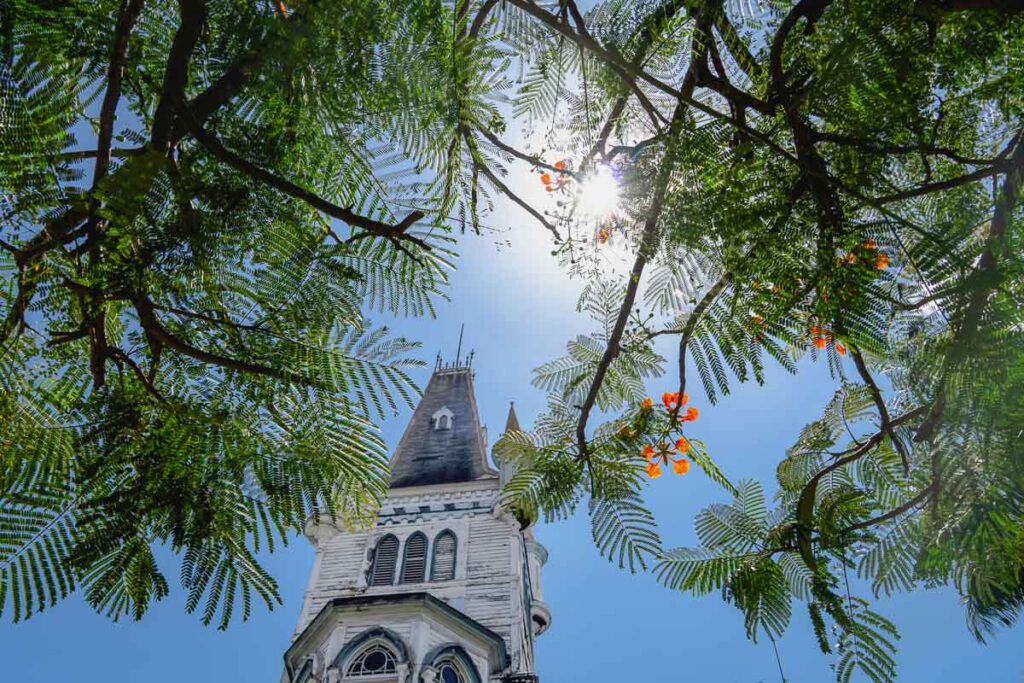
Before you Go: Suriname Entry Requirements
Travel Documents
As for any official international country crossing, you will need travel documents, such as a passport.
Suriname Visa
Suriname has visa requirements to enter. Most nationalities are eligible to apply online for an e-visa which can take up to 3 days to process. Here is the Surinamese authorized site that we used to get the visa: vfsglobal.com
Before being accepted, we received feedback requesting additional submissions of our flight schedule departing from Suriname and a colored scan of our passport bio-data page. In total, our application was finalized successfully in two days.
An E-Tourist Card single entry visa is valid for three months and costs $54 USD ($40 Visa Fee plus $14 processing fee). If you are looking for a multiple entry visa, other options and prices are listed here.
COVID-19
As of July 2021, Suriname reopened for tourism with no quarantine rules. However, you must present the following, or else you will need to submit a PCR or antigen test result (May 2022). This is only applicable to people who are traveling to Suriname by land.
- Must be fully vaccinated or can present Covid-19 recovery certificate not older than six months
- Must have stayed in Guyana for French Guiana at least 14 days prior to entering Suriname
If both factors are not met, you will need to arrange a Covid-19 test in Guyana no older than 48 hours for PCR or 24 hours for antigen tests. Unless things have changed since October 2021, covid testing in Guyana is not cheap.
We had gone to Eureka Medical Laboratories Inc in Berbice, where PCR tests ran $130 USD per person. The clinic didn’t accept credit or debit cards, only cash, but was lenient with taking USD.
Covid testing in Guyana seems to hover at that price point. The clinic didn’t have antigen tests at the time, but those are typically cheaper if available now.
Yellow Fever Vaccination
Suriname border staff will ask to see your yellow fever vaccination. If you have already gotten vaccinated, bring your yellow fever vaccine certificate on the trip.
If you have not gotten vaccinated yet, the Georgetown hospital provides shots for $5-$10 USD. The hospital hours vary, and they may ask you to return at a different time.
Your certificate will not be valid until at least 10 days after receiving the vaccine. If you know you are traveling to Suriname and do not have the yellow fever vaccination yet, do so as early as possible. Otherwise, you will have to leave it to luck that immigration officers don’t block you from entering.
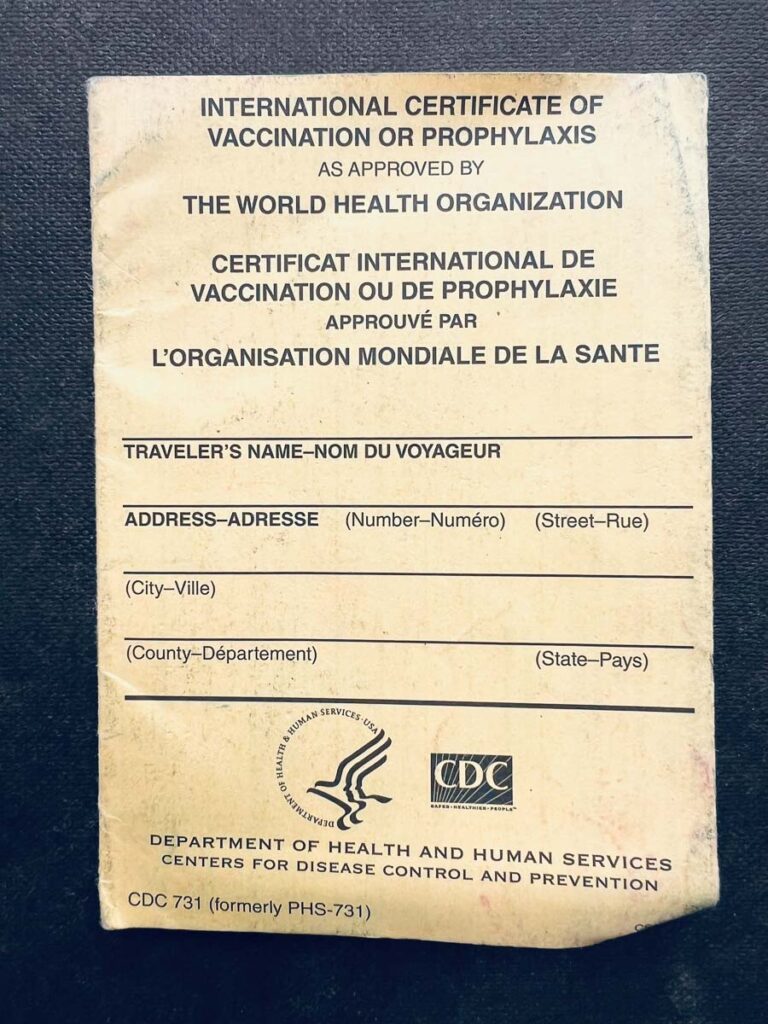
General Route of Overland Travel from Guyana to Suriname
Two transport options from Guyana to Suriname:
- Book a transportation service to directly take you
- Rely on shared taxis and public transportation
Route Recommendation
We opted to make our own two day adventure along the coast to the Guyana-Suriname border.
But, if we were to do it again, I would say book a transportation service. A preplanned service saves you so much hassle for nearly the same cost and travel duration. Also, there’s not too much to see along the Guyanese coast.
Start & Ending Point: Georgetown, Guyana and Paramaribo, Suriname
Guyana and Suriname do not have well-established tourist routes. You will likely start any trip from their capitals, Georgetown, Guyana to Paramaribo, Suriname.
To cross from Guyana to Suriname, you will start both overland travel methods from Georgetown city center.
Guyana to Suriname Ferry Schedule
Before traveling from Guyana to Suriname, check the latest information on how frequently the official ferry crosses. There is only one ferry company, Canawaima Ferry.
It takes 30 minutes to cross from Moleson Creek, Guyana to South Drain, Suriname.
In the past, the ferry transited back and forth once a day on a daily basis. Due to Covid-19, the government restricted schedules to run only two crossings per week, once a day on Wednesday and Friday at 10am, then returning to Guyana from Suriname at 1pm. (October 2021).
Fact-checking on Google, it seems in late October 2021, ferry crossings may have increased to three times per week (Monday, Wednesday, and Friday). Looser restrictions may have since brought back daily crossings.
I have heard that locals sell illegal crossings that will take you over the river from Guyana to Suriname. However, immigration will not be open outside of ferry crossing times, therefore, you will not have a way to receive an exit/entry stamp into Suriname. Make sure that as a foreigner, you are taking the legal way as the police en route to Paramaribo may check your passport and entry stamps.
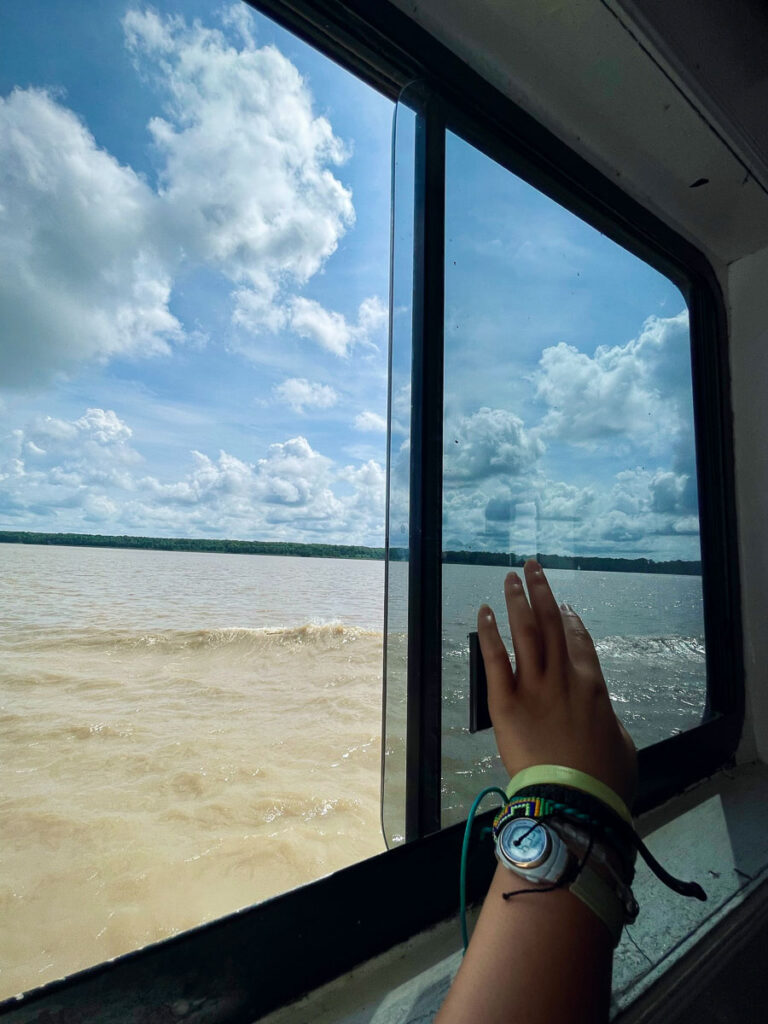
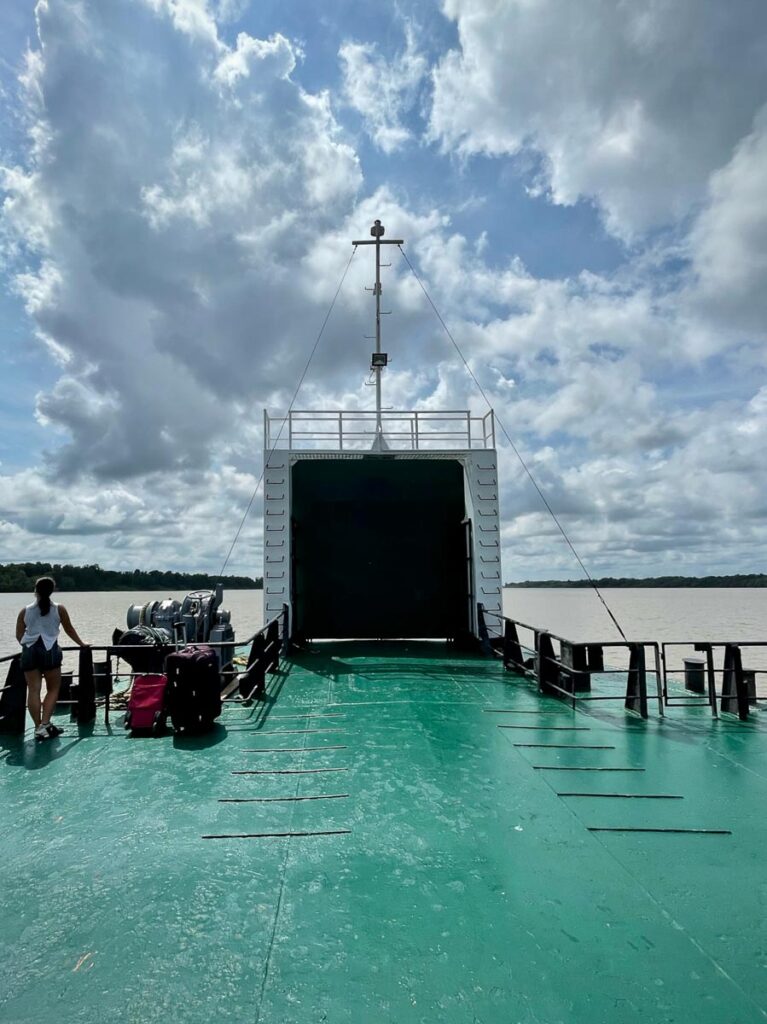
How Much Does it Cost to Travel from Guyana to Suriname?
I could only reach one reasonable contact to book the transportation service. They proposed a $50 fare per person, not including the ferry ticket.
If you plan to take public transportation or shared taxis, the cost will be more or less the same as a transport service. ~$15-$20 direct bus to Moleson Creek, then $20 from the port to Paramaribo.
Ferry tickets cost $15-$20 per person, which you will pay in cash directly at the port. $15 gets you a one-way ticket, and $20 gets you a roundtrip ticket with an open return valid for a month.
1. Booking a Transport Service from Guyana to Suriname
Transport Service Itinerary:
- 4 – 5am early morning pick up at your guesthouse or accommodation in Georgetown, Guyana
- Drive to Moleson Creek ferry terminal ~3 hours
- Get through immigration, and wait for the ferry
- Ride the ferry for 30 minutes
- Border cross entry stamp
- South Drain to Paramaribo, Suriname in ~4 hours
At Moleson Creek, you will receive a voucher to show a driver on the Suriname side who will take you to Paramaribo.
Local Contacts to Find A Transport Service
Unlike touristy destinations, available transportation options to travel from Guyana to Suriname do not show up on the first page of Google.
Find tour operators or discuss with your guesthouse staff, they can recommend transportation services. I met one tour operator at a bar, who priced his trips insanely, think $1000 for a one overnight trip, meals not included. So I’m not sharing his info, but make sure you don’t get price gouged.
I scoured Google, Facebook, and other travel blogs and could only find a few contacts. I have personally spoken to contact 1, but if he is unavailable, try the other numbers. Here is their information:
- Contact: Use Whatsapp, personally verified
- Phone: +592 628 3064
- Cost: $50 USD + $20 Ferry Ticket
- Contact: Justin’s Bus Service
- Phone: +592 613 6556
- Website: https://justinsbusservices.page.tl/
- They also use Facebook
- Contact: Paul and Adele
- Phone: +5926286001 (Paul) | +5926884938 (Adele)
- Contact: Dugla
- Phone: +592 612 8047
2. Independent Travel from Guyana to Suriname (Public/Shared Transportation)
Navigating the Local Guyanese Bus System
If you want to make stops on your overland travel, busses and shared taxis run all day from Stabroek Market. The market acts as a transportation hub; all buses will make a stop or leave from there.
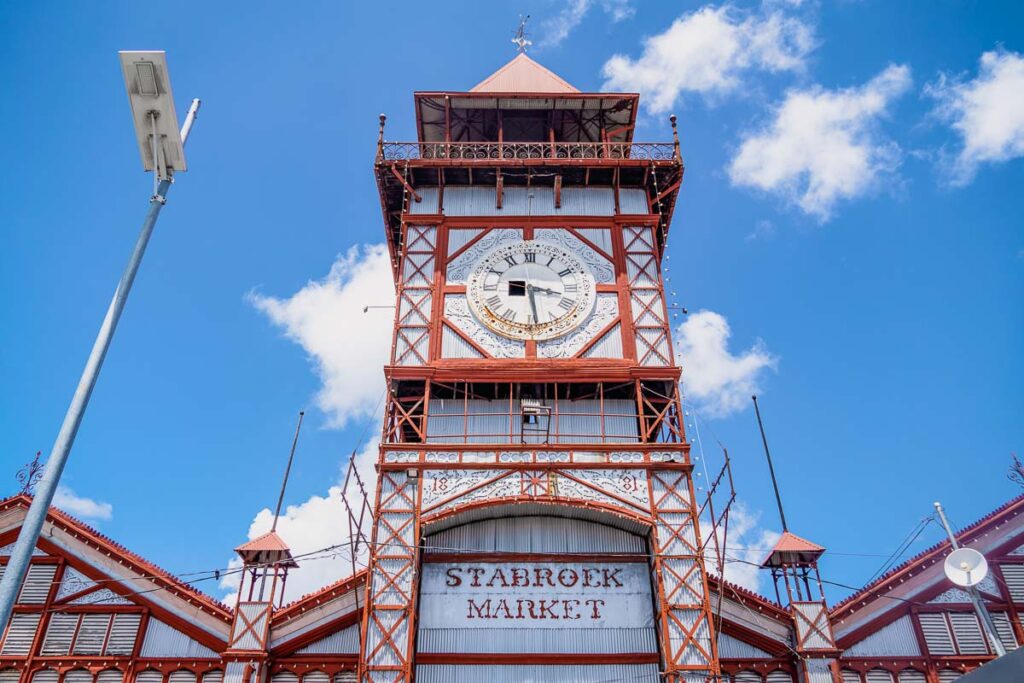
Shared Taxi vs. Public Bus
Public Bus
Take the 63 bus to Moleson Creek. It costs:
- 3000 GYD ($15 USD) to Moleson Creek
- 2000 GYD ($10 USD) to Berbice
- 1000 GYD ($5 USD) to Rosignol
- Neighbors to Berbice, but the nearby bridge has a toll cost
Buses do not leave at set times, save for the one at 3am for Moleson Creek. All others will wait for every bus seat to fill before leaving. You may be lucky and take the last spot on the bus or wait an hour for enough people to join for the next bus.
Shared Taxi
As much as the locals are eager to help, the “Taxi Mafia” will start to strike the moment they realize you are trying to go somewhere. Ten, twenty taxi drivers will attempt to lure you with the lowest prices and immediate leaving time.
There is almost no price difference between a shared taxi and a bus!
The shared taxi will need 3 people minimum and start you on the way, presumably driving faster than a bus.
2a. Direct Public Transportation
If you plan to cross the morning of, there is public transportation that leaves at 3 am that can be arranged to pick you up from your hotel/hostel.
Bus 63 will bring you all the way to Coverrinton. You will then need a taxi to drive you the rest of the way to the ferry terminal. It should cost about 3000-4000 local Guyanese dollars to take you ($15-$20).
With such an early start, you should arrive in about 4 hrs at around 7-7:30am.
Why so early if the ferry leaves at 10am? Locals recommended we arrive super early at the ferry terminal since there are so many immigration checkpoints and long queuing due to decreased ferry departures. Immigration stations can close if you arrive too late, where you would then have to wait for the next ferry for a couple days.
2b. Indirect Public Transportation
Using public transportation is a great way to break up the journey from Guyana to Suriname by stopping in towns to sightsee along the way.
We chose to depart two days before the ferry crossing. Before making it over the Suriname river, we embarked on a series of confusing transportation and spent overnights in Berbice (also named New Amsterdam) and Corriverton.
We did a shared taxi to Berbice, a bus to Coverrington, and a shared taxi to Moleson Creek.
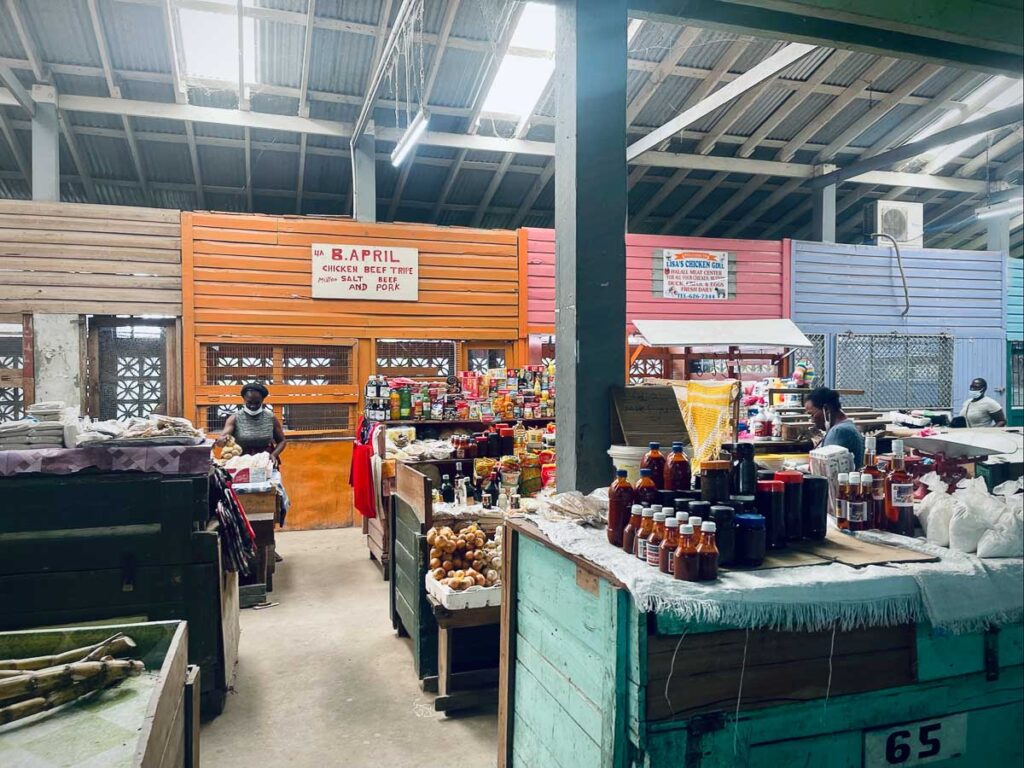
Guyana – Suriname Border Crossing Immigration Process
At the ferry crossing, staff corrals you into a sheltered wooden structure with everyone else. The Guyanese side had five quite rude immigration checkpoints asking to repeatedly look at your documents.
Under the wooden structure, the initial check will ensure you have all the correct paperwork before allowing you to enter the immigration office. Check again, and buy the ferry tickets. Two more checks and an exit stamp later, you will arrive at the waiting area with a bathroom and a small food stand.
After a final passport check, boarding started at 10:20am, and at 10:40am, the ferry pushed off from the port.
The boat ride from Guyana to Suriname is a short trip, lasting around 30 minutes. The boat cuts through the muddy river crossing with Amazon-lined trees flanked on both sides to arrive in South Drain, Suriname.
On the Suriname side, clear through immigration with noticeably friendlier staff in about 30 minutes before the final leg of the journey. Seniors are allowed first in line, so the line may take longer.
South Drain Port to Paramaribo, Suriname
If you booked a service, show your voucher to the awaiting bus driver before heading out past Nieuw Nickerie.
If you independently traveled, buses will wait for their seats to fill up, like in Guyana. If you don’t want to delay, shared taxis are available. Taking a shared taxi costs 20$ per person for a 4 hr drive straight to Paramaribo.

Other Border Crossing Tips
Time Difference
Suriname has a one hour time difference from Guyana, so your clocks will jump forward in the waiting area of the ferry.
Money Exchange
Both sides of the border have money exchange vendors offering to exchange Guyana Dollars with Suriname Dollars. The exchange rate would be better if you traded in the city, but it would be good to have some local currency.
Police Checkpoints: Suriname
Police checks occurred a few times on the 4 hour drive to make sure you legally entered the country. I heard that this only happens in personal cars, not buses. You just need to show a passport, and it will be returned soon after.
Transport Will Stop for Food
Much of the way will be through the remote jungle. Along the way, buses and taxis will stop at a food stall for you to pick up a meal before continuing.
The Wrap Up: Navigating the Land Border from Guyana to Suriname
As the vehicle bumped along the pothole dirt roads of Suriname, tiny jungle villages and scattered houses broke the never-ending jungle sight. On the cusp of the city, we realized how different the colorful British buildings of Guyana contrasted from the white Dutch Colonialism architecture in the historic inner city of Paramaribo.
Not much information about this route is easy to find, so I hope this guide was helpful for how to travel across the land border from Guyana to Suriname.
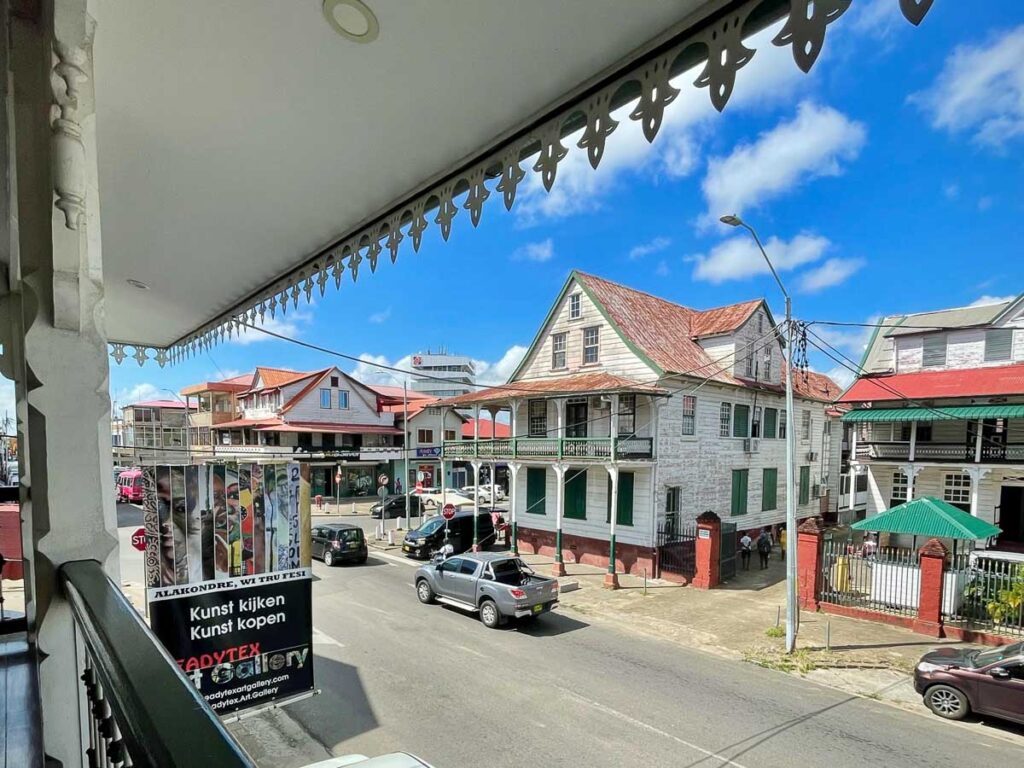
Catherine Xu is the founder and author of Nomadicated, an adventure travel blog that helps travelers cross off their bucket list. Since discovering traveling in 2015, she has lived and journeyed to 65 countries across 5 continents and vanlifed the west coast USA for 2+ years. These days, she splits her time in Southeast Asia and California while sharing her travel stories and resources based on first-hand experiences. Catherine's other works has been referenced in major publications like MSN, Self, and TripSavvy.

